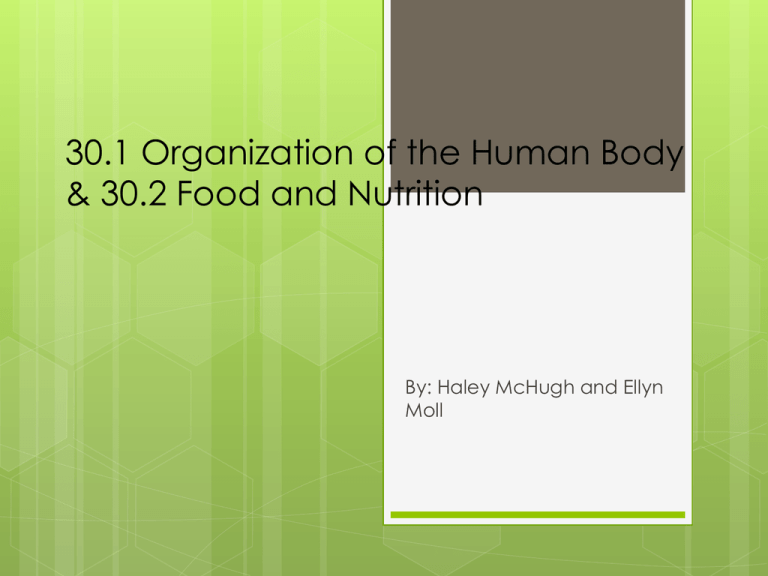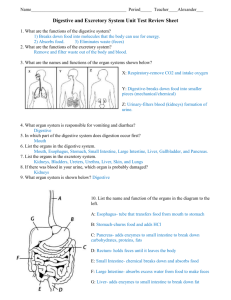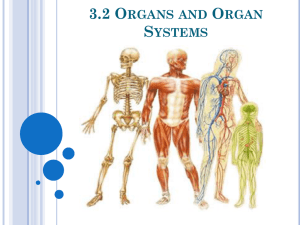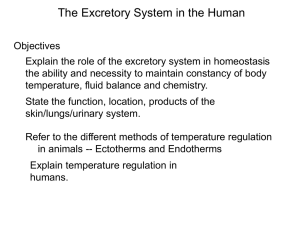Bio chapter 30 ppt
advertisement

30.1 Organization of the Human Body & 30.2 Food and Nutrition By: Haley McHugh and Ellyn Moll How the Body is Organized The levels of organization in the body include cells, tissues, organs, and organ systems. At each level of organization, these parts of the body work together to carry out the major body functions Cells and Tissues A cell is the basic unit of structure and function in living things. Individual cells in multicellular organisms tend to be specialized. Specialized cells, such as bone cells, blood cells, and muscle cells, are uniquely suited to perform a particular function. A group of cells that perform a single function is called a tissue. There are four basic types of tissue in the human bodyepithelial, connective, nervous, and muscle. Organs and Organ Systems A group of different types of tissue that work together to perform a single function or several related functions is called an organ. An example is an eye, the eye is an organ made up of epithelial, nervous, muscle, and connective tissue. As different as these tissues are, they work together for a single function. An organ system is a group of organs that perform closely related functions. An example of an organ system is the brain and spinal cord, these two are organs of nervous system. The organ systems interact to maintain homeostasis in the body as a whole. Homeostasis Homeostasis describes the relatively constant internal physical and chemical conditions that organisms maintain despite changes in internal and external environments It keeps internal conditions in a certain range, not letting them go too far to one side or the other. One example is the maintenance of body temperature. Homeostasis keeps you from getting to cold by heating the body; this mechanism is similar to a home heating system. It also keeps you from getting to hot, by slowing down cellular activity and producing sweat, which cools the bodies surface by evaporation. Energy •When food is burned, most energy in the food is converted to heat, which is measured in terms of calories. •The energy stored in food molecules is released during cellular respiration and used to produce the ATP molecules that power cellular activities. Raw Materials and Minerals Food supplies the raw materials used to build and repair body tissues. Some of these raw materials are needed to make enzymes, the lipids in cell membranes, and even DNA. Food contains at least 45 substances that the body needs but cannot manufacture. Minerals are inorganic nutrients that the body needs, usually in small amounts. A constant supply of minerals in the diet is needed to replace those lost in sweat, urine, and digestive wastes. Water Every cell in the human body needs water because many of the body’s processes, including chemical reactions, take place in water. Water makes up the bulk of blood, extracellular fluid, and other bodily fluids. On hot days or during exercise, sweat glands remove water from your tissues and release it as sweat on the surface of your body. Water is also lost in urine and with every breath you exhale. Carbohydrates Simple and complex carbohydrates are a major source of energy for the body. The sugars found in fruits, honey, and sugar cane are simple carbohydrates. The starches found in grains, potatoes, and vegetables are complex carbohydrates. Starches are broken down by the digestive system into simple sugars. These molecules are absorbed into the blood and carried to cells throughout the body; Excess blood sugar is converted into glycogen, which is stored in the liver and in skeletal muscles or converted to and stored as body fat. Fats Fats, or lipids help the body absorb fat-soluble vitamins and are a part of cell membranes, nerve cells, and certain hormones. Deposits of fat protect and insulate body organs and are a source of stored energy. Based on the structure of their fatty acid chains, fats are classified as saturated or unsaturated. Food manufacturers often modify unsaturated fats in vegetable oils by adding hydrogen to them. These processed fats are called trans fats. Trans fats have a longer shelf life than unsaturated fats. Recent studies suggest that trans fats may be associated with serious health concerns, including heart disease. Proteins Proteins supply raw materials for growth and repair of structures such as skin and muscles. Proteins also have regulatory and transport functions; For example, the hormone insulin is a protein that regulates the level of sugar in the blood. And hemoglobin, a protein found in red blood cells, help transport oxygen. Proteins are polymers of amino acids. The body is able to synthesize only 12 of the 20 amino acids used to make proteins; the other 8 are called essential amino acids. Essential amino acids must be obtained from the food you eat. Vitamins Most vitamins are needed by the body to help perform chemical reactions. Most vitamins must be obtained from food; however, the bacteria that live in the large intestine are able to synthesize vitamins K and B There are two types of vitamins: fat-soluble and water-soluble. Fat-soluble(A,D,E, and K) can be stored in the fatty tissues of the body. The body can build up small deposits of these vitamins for future use. Water-soluble(C and B) dissolve in water and cannot be stored in the body. The Digestive System Function of Digestive System • • • • Describes the organs of the digestive system and their what they do. Explain the process of the digestive system. Describe how nutrients are absorbed and wastes are eliminated. The Function of the digestive system is break down and absorb nutrients from food to give energy to the body. Process of the Digestive System The process of the digestive system starts in the mouth. Once through there is passes the salivary gland then the pharynx, then goes into the epiglottis and pass the bolus. From there is makes its way down the esophagus Then it goes into the stomach and through the liver, pancreas, and then the gallbladder. After it goes through all of those it makes it way through the small and large intestines to the anus, and that s the end of the digestive system. Types of Digestion Mechanical Digestion: when you use your mouth to break down foods. Its physical. Chemical Digestion: food is broken down by chemicals inside you body. Its changed into a molecular level. The Excretory System The excretory system includes your skin, lungs, liver and kidneys. It excretes metabolic waste from body. The process by which these metabolic wastes are eliminated to maintain homeostasis is called excretion. Skin The skin excretes excess water, salts and a small amount of urea from sweat. By releasing swear in very small amounts, waste is removed even when you may not think you’re sweating Lungs Blood transports carbon dioxide from the body cells to the lungs. When you exhale you lungs excrete carbon dioxide and small amounts of water vapors. Liver Liver plays an important role in the excretory system. The liver breaks down nitrogen wastes into less toxic urea. Urea is high soluble, and is then transported through the blood to the kidneys for elimination from the blood. Kidneys The major organ of the excretory system are the kidneys. Fist-sized organs located on either side of the spinal column near the lower back. Kidneys are like filters, they filter out excess water , urea, and metabolic wastes from the blood. The kidneys also produce and excrete a waste product known as urine. KINDNEYS ARE VERY IMPORTANT! Vocab Ureters: Transports urine from the kidneys to the urinary bladder. Urinary bladder: Where the urine is stored until it is released through the urethra. Urethra: Tube through which urine leaves the body. Structure of the Kidney











